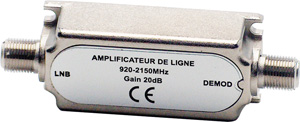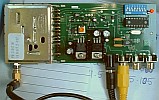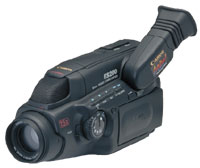G6GVI's simple ATV equipment for 23, 13 and 3cm
All my ATV equipment dates back to 1999, but it still works effectively, and shows what can be done with simple "old-fashioned" technology.
This page is not intended to be a "get started in ATV" guide, just a brief explanation of the equipment I have evolved over the years for my (mainly portable) ATV operations.
I'll take some piccies of the kit next time I have it out, and add them to this article.
23cm receiving equipment
Amstrad analogue satellite set-top box
 These were very commonly-available for next-to-nothing a few years ago, as all BSkyB users upgraded to digital equipment. You may still have one stashed away in your loft?
These were very commonly-available for next-to-nothing a few years ago, as all BSkyB users upgraded to digital equipment. You may still have one stashed away in your loft?
They provide most of what is needed for 23cm ATV reception: a tuner which covers the 1240-1320 band (even with digital display and automatic frequency control), and outputs to drive a TV via SCART or UHF. They even provide a DC supply on the RF input, to supply a mast-head amplifier.
The earlier SRX100 models did not have a 6.0MHz sound decoder, so a crystal change was needed, but the later models allowed selection of different audio sub-carrier frequencies from the front panel.
It's a convenient mains-powered unit for shack use. The only modification required to my SRX200 was to wind up the internal video gain control. I then used it for years in the G3KAC shack to receive the GB3ZZ and (with a downconverter) GB3XG ATV repeaters in Bristol.
Philips tuner module
 I salvaged this "tin can" out of an old BSB/MarcoPolo DMAC receiver, and it ended up in a die-cast box as the heart of my portable ATV receiver. I added a multi-turn potentiometer for tuning, an inverting video amplifier, and a sub-carrier sound receiver.
I salvaged this "tin can" out of an old BSB/MarcoPolo DMAC receiver, and it ended up in a die-cast box as the heart of my portable ATV receiver. I added a multi-turn potentiometer for tuning, an inverting video amplifier, and a sub-carrier sound receiver.
It runs off 12V, and so I use it as the receiver for all my portable operations.
Casio LCD TV
This was state-of-the-art when I bought it, but now the display looks very small and not very bright. I run it off 5V (using a SMPS from a 12V battery), and connect the audio and video in directly from my portable receiver. Despsite the picture opposite, it is a colour unit. The test card on the display was received on 3cm from Cardiff to Bristol, across the Severn Estuary.
"Masthead pre-amp"
 I have had some success using a simple satellite "cable-booster" as an RF front-end. The disadvantage is that they are broadband, and so easily de-sensed by other signals (including my 2m talkback!). Fitting a 23cm band-pass filter between the antenna and pre-amp sorted this out.
I have had some success using a simple satellite "cable-booster" as an RF front-end. The disadvantage is that they are broadband, and so easily de-sensed by other signals (including my 2m talkback!). Fitting a 23cm band-pass filter between the antenna and pre-amp sorted this out.
By design, they will take their DC supply from the receiver via the feeder, but remember to block the DC from the "LNB" port, otherwise it will be shorted out by the filter or antenna feed!
I eventually built myself a little MMIC pre-amp with an integrated filter to simplify portable operations.
Jaybeam 23cm antenna
 I got this old 15-over-15 slot-fed yagi third-hand from a kindly amateur back in 1995, and have used it for all my 23cm ATV (and narrowband SSB) portable operations ever since.
I got this old 15-over-15 slot-fed yagi third-hand from a kindly amateur back in 1995, and have used it for all my 23cm ATV (and narrowband SSB) portable operations ever since.
Whereas my 23cm loop-quad antenna is built for narrowband use around 1296MHz, the Jaybeam has a wide enough bandwidth to cover the ATV bands too.
Comtech 23cm receiver
 I've recently aqcuired one of these more modern synthesized receivers, for use in the car. It will run off 12V, and its video output is fed to the head unit of my IC-2800 transceiver (which has a convenient composite video input!). I intend to add an audio output to the car's sound system too.
I've recently aqcuired one of these more modern synthesized receivers, for use in the car. It will run off 12V, and its video output is fed to the head unit of my IC-2800 transceiver (which has a convenient composite video input!). I intend to add an audio output to the car's sound system too.
It's a compact and convenient system which needs very little setting-up compared with my original receiver, so I hope to use it more often to check for ATV activity when I'm out portable on the hills.


23cm transmitting equipment
BATC kit transmitter
This is a simple transmitter based on a free-running VCO. It includes a 6MHz sound sub-carrier generator and the output is about 1.5W from a Mitsubishi module. I've set it to tune between approximately 1245 and 1260MHz (I use a pocket frequency counter to set the TX frequency more accurately).
External PA/preamp unit
Although most of my QSOs can be conducted with the 1.5W output from the BATC TX, I also have a home-made PA/preamp unit using a Mitsubishi 15W module and a GaAsFET pre-amp, switched with co-axial relays.
The PA is a linear module, and I built this unit mainly for SSB operation, but it can be pressed into service for FM-ATV too!
Canon camcorder
 This is my portable video and audio source. I used to be able to transmit pre-recorded clips over the air, but now that the tape mechanism is jammed, it's just a camera with built-in mike for live sound and pictures. But the remote-control zoom and caption generator still work!
This is my portable video and audio source. I used to be able to transmit pre-recorded clips over the air, but now that the tape mechanism is jammed, it's just a camera with built-in mike for live sound and pictures. But the remote-control zoom and caption generator still work!
The old NiCd and metal hydride batteries are getting rather tired now, so I'll be using a 6V gel-battery to power it.
13cm equipment
Receive converter
This is home-built unit which amplifies the incoming 2.3GHz signal and down-converts to 1.3GHz. I added another 10dB of gain after the mixer too. The unit takes its DC supply from the receiver, via the RF feeder.
Transmitter and PA
 The transmitter is another home-built unit, based on a Mini-Circuits VCO, and including a 6MHz sound sub-carrier generator. The output is only around 5mW, which is sufficient for a lot of QSOs, but I also have a 1W amplifier built from a DL2AM kit.
The transmitter is another home-built unit, based on a Mini-Circuits VCO, and including a 6MHz sound sub-carrier generator. The output is only around 5mW, which is sufficient for a lot of QSOs, but I also have a 1W amplifier built from a DL2AM kit.
As on 23cm, I use a pocket frequency counter to set my precise TX frequency.
Antennas
I built an 18-ele loop-yagi from the published G3JVL design, using tinned copper wire to form my loops (but I know one enterprising individual who used appropriately-sized curtain rings for his!).
I also cobbled together a "bow-tie dipole" and rudimentary trough reflector as a compact portable antenna (since it quickly dismantles into small sections). I once used this to send 13cm pictures from the top of Bristol's Cabot Tower across the City.
3cm equipment
Downconverter
This is a satellite LNB (for the 12GHz band) modified to downconvert from 10.3 to 1.3GHz. The modifications involved packing the dielectric resonator to lower its frequency, and soldering tiny strands of wire to the "hairpins" in the band-pass filter.
The LNB still takes its DC supply from the receiver, via the RF feeder.
In use, the LNB is mounted at the offset-feed of a small 30cm portable dish.
Transmitter
This uses a Gunn-diode module from an old Solfan Doppler motion-detector alarm. The output power is just 10mW, but when mounted with a penny-feed on a PW Exe prime-focus dish, the EIRP is of the order of watts. The modulator is home-made, and includes a 6MHz audio sub-carrier generator.
The device is essentially fixed-frequency (set by a mechanical tuning screw in the cavity), but some fine-tuning is possible by adjusting the bias voltage on the Gunn-diode. My frequency is currently set for 10.315GHz (the input frequency of GB3XG).
The proof of the pudding...
I used the equipment described above for my portable operations back in 2000, when the Severnside ATV Group ran a Millennium Trophy competition. The scoring system rewarded high frequency and low-power, so my 13 and 3cm contacts with milliwatts were particularly fruitful, and I ended up winning the event.
Here is a list of my contacts from that year (note that another requirement of each successful contact was to have a live picture identified by the receiving station on the talkback - no test-cards were allowed!).
If you're interested in more details of this equipment, please
email me.
 These were very commonly-available for next-to-nothing a few years ago, as all BSkyB users upgraded to digital equipment. You may still have one stashed away in your loft?
These were very commonly-available for next-to-nothing a few years ago, as all BSkyB users upgraded to digital equipment. You may still have one stashed away in your loft?
 I salvaged this "tin can" out of an old BSB/MarcoPolo DMAC receiver, and it ended up in a die-cast box as the heart of my portable ATV receiver. I added a multi-turn potentiometer for tuning, an inverting video amplifier, and a sub-carrier sound receiver.
I salvaged this "tin can" out of an old BSB/MarcoPolo DMAC receiver, and it ended up in a die-cast box as the heart of my portable ATV receiver. I added a multi-turn potentiometer for tuning, an inverting video amplifier, and a sub-carrier sound receiver.
 I have had some success using a simple satellite "cable-booster" as an RF front-end. The disadvantage is that they are broadband, and so easily de-sensed by other signals (including my 2m talkback!). Fitting a 23cm band-pass filter between the antenna and pre-amp sorted this out.
I have had some success using a simple satellite "cable-booster" as an RF front-end. The disadvantage is that they are broadband, and so easily de-sensed by other signals (including my 2m talkback!). Fitting a 23cm band-pass filter between the antenna and pre-amp sorted this out.
 I got this old 15-over-15 slot-fed yagi third-hand from a kindly amateur back in 1995, and have used it for all my 23cm ATV (and narrowband SSB) portable operations ever since.
I got this old 15-over-15 slot-fed yagi third-hand from a kindly amateur back in 1995, and have used it for all my 23cm ATV (and narrowband SSB) portable operations ever since.
 I've recently aqcuired one of these more modern synthesized receivers, for use in the car. It will run off 12V, and its video output is fed to the head unit of my IC-2800 transceiver (which has a convenient composite video input!). I intend to add an audio output to the car's sound system too.
I've recently aqcuired one of these more modern synthesized receivers, for use in the car. It will run off 12V, and its video output is fed to the head unit of my IC-2800 transceiver (which has a convenient composite video input!). I intend to add an audio output to the car's sound system too.


 This is my portable video and audio source. I used to be able to transmit pre-recorded clips over the air, but now that the tape mechanism is jammed, it's just a camera with built-in mike for live sound and pictures. But the remote-control zoom and caption generator still work!
This is my portable video and audio source. I used to be able to transmit pre-recorded clips over the air, but now that the tape mechanism is jammed, it's just a camera with built-in mike for live sound and pictures. But the remote-control zoom and caption generator still work!
 The transmitter is another home-built unit, based on a Mini-Circuits VCO, and including a 6MHz sound sub-carrier generator. The output is only around 5mW, which is sufficient for a lot of QSOs, but I also have a 1W amplifier built from a DL2AM kit.
The transmitter is another home-built unit, based on a Mini-Circuits VCO, and including a 6MHz sound sub-carrier generator. The output is only around 5mW, which is sufficient for a lot of QSOs, but I also have a 1W amplifier built from a DL2AM kit.